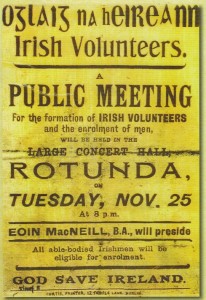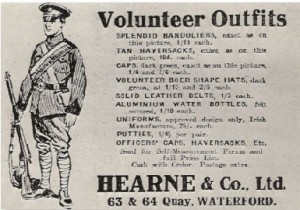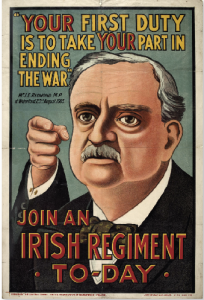Whatever happened to the Irish Volunteers?
Published in 1913, Blogging Irish History, Decade of Centenaries, Home Rule Crisis, Revolutionary Period 1912-23 Monday 25 November marks the centenary of the foundation of the Irish Volunteers: an organization that remains strangely neglected by historians. There are a couple of articles on the Volunteers in the current issue of History Ireland, but a quick glance through our back catalogue didn’t turn up much. We have some very good articles on the UVF (such as this by Timothy Bowman, from our March/April 2013 issue). We have no shortage of articles on the various successor organizations to the Irish Volunteers, but virtually nothing on the Volunteers themselves.
Monday 25 November marks the centenary of the foundation of the Irish Volunteers: an organization that remains strangely neglected by historians. There are a couple of articles on the Volunteers in the current issue of History Ireland, but a quick glance through our back catalogue didn’t turn up much. We have some very good articles on the UVF (such as this by Timothy Bowman, from our March/April 2013 issue). We have no shortage of articles on the various successor organizations to the Irish Volunteers, but virtually nothing on the Volunteers themselves.
This isn’t unusual. Irish Academic Press have just reissued the valuable compendium of recollections and documents edited by F.X. Martin for the fiftieth anniversary of the foundation of the volunteers in the Rotunda Hospital in Dublin. But this remains the best guide to understanding them, for there is no substantial modern study. Compare that to the raft of books and studies on the various groups to claim the name IRA, not to mention the Irish National Army and Defence Forces: all organizations that would not have come into being without the creation of the original volunteers, and who still claim the name ‘volunteers’/ ‘óglaigh’.
 There seems to be a standard narrative about the Irish Volunteers. They were formed in response to the UVF (though they seemed to be at pains to point out that their real opponent was the Conservative Party rather then their unionist counterparts). They later engaged in some limited gun-running, and then split in 1914 when John Redmond urged that they participate in the British war effort. The rump that broke off ultimately went on to fight in the Easter Rising. But what of the ones who did not? The more eye-catching but insignificant Irish Citizen Army has received disproportionate attention and been the subject of a degree of wishful thinking, but what of their much larger contemporaries? On the eve of the Easter Rising – 17 April 1916 – the British authorities estimated that the membership of the Irish Volunteers stood at 8,381; that of the Redmondite National Volunteers, however, was estimated at 104,084. The sheer numbers involved in the National Volunteers points to a large swathe of Irish life that remains somewhat overlooked. The British did, however, view the Irish Volunteers as the most active organization on the island of Ireland prior to the Rising (though the estimates of weapons held by the major militias in January 1916 tells a story in itself: the Irish Volunteer had had 2,534 rifles, the Irish National Volunteers had 9,834, and the UVF had a staggering 53,539).
There seems to be a standard narrative about the Irish Volunteers. They were formed in response to the UVF (though they seemed to be at pains to point out that their real opponent was the Conservative Party rather then their unionist counterparts). They later engaged in some limited gun-running, and then split in 1914 when John Redmond urged that they participate in the British war effort. The rump that broke off ultimately went on to fight in the Easter Rising. But what of the ones who did not? The more eye-catching but insignificant Irish Citizen Army has received disproportionate attention and been the subject of a degree of wishful thinking, but what of their much larger contemporaries? On the eve of the Easter Rising – 17 April 1916 – the British authorities estimated that the membership of the Irish Volunteers stood at 8,381; that of the Redmondite National Volunteers, however, was estimated at 104,084. The sheer numbers involved in the National Volunteers points to a large swathe of Irish life that remains somewhat overlooked. The British did, however, view the Irish Volunteers as the most active organization on the island of Ireland prior to the Rising (though the estimates of weapons held by the major militias in January 1916 tells a story in itself: the Irish Volunteer had had 2,534 rifles, the Irish National Volunteers had 9,834, and the UVF had a staggering 53,539).
 But in the years and months prior to the rising it wasn’t uncommon for the Irish Volunteers to be jeered by the Irish public while on their weekly marches and manouvres, to be attacked by their Redmondite rivals, and occasionally to be saved from both by the RIC. The British authorities took the view that the espousal of ‘Sinn Fein’ beliefs prior to 1916 was often little more then an excuse for declining to enlist. It would seem that many Irish people felt the same way: prior to 1916, who looked like the toy soldiers? The experience of many of the Irish National Volunteers was folded up in the First World War. But the original Irish Volunteers remain a seminal organization in the Irish Revolution: the north may well have begun, as Eoin MacNeill suggested, but it was the Irish Volunteers who made the next move by militarizing nationalist Ireland. For that reason alone they deserve more attention then they usually get.
But in the years and months prior to the rising it wasn’t uncommon for the Irish Volunteers to be jeered by the Irish public while on their weekly marches and manouvres, to be attacked by their Redmondite rivals, and occasionally to be saved from both by the RIC. The British authorities took the view that the espousal of ‘Sinn Fein’ beliefs prior to 1916 was often little more then an excuse for declining to enlist. It would seem that many Irish people felt the same way: prior to 1916, who looked like the toy soldiers? The experience of many of the Irish National Volunteers was folded up in the First World War. But the original Irish Volunteers remain a seminal organization in the Irish Revolution: the north may well have begun, as Eoin MacNeill suggested, but it was the Irish Volunteers who made the next move by militarizing nationalist Ireland. For that reason alone they deserve more attention then they usually get.
The Defence forces have organized an exhibition on the foundation of the Irish Volunteers that is on display each day in the Pillar Room of the Rotunda Hospital from 25-29 November; it is open 10am-4pm Monday-Wednesday, 10am-7.30pm Thursday, and 10am-2pm on Friday.
Diarmaid Ferriter also had a very good article on the Irish Volunteers in the weekend section of the Irish Times (23 Nov), if you haven’t done your recycling yet.
There is also the latest edition of the RTE/Boston College online Century Ireland project: an excellent special issue on the foundation of the Irish Volunteers, that can be read here.
Finally, our next Hedge School will be in Belfast City Hall on 10 December on the broad topic of ‘volunteering’. For more details, click here.
John Gibney
Further reading:
Breandán Mac Giolla Choille (ed), Intelligence Notes, 1913-16 (Dublin/BÁC, 1966).
F.X. Martin (ed), The Irish Volunteers, 1913-1915: Recollections and documents (Merrion, 2013 ed.).
P.S: There are a couple of more recent short studies of the Volunteers in a number of edited volumes: D.G. Boyce & Alan O’Day (eds), The Ulster Crisis, 1885-1922 (2005); and Colin Reid & Caoimhe Nic Dháibhéid (eds), From Parnell to Paisley (2010). They are also discussed in Matthew Kelly, The Fenian ideal and Irish nationalism, 1882-1916 (2006). All are available to consult in National Library of Ireland, amongst other places. Thanks to Matt Kelly for pointing these out.
















